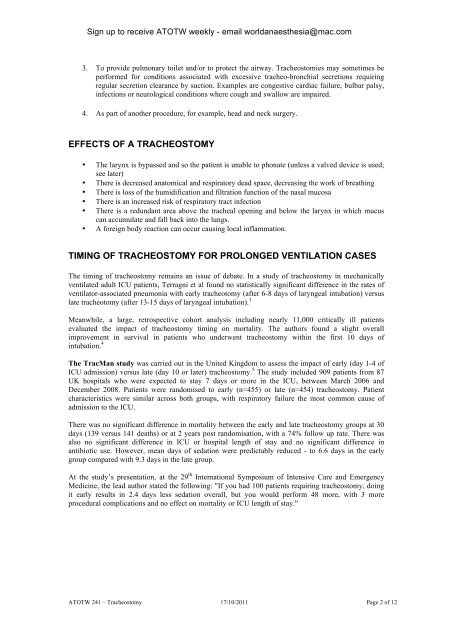TRACHEOSTOMY ANAESTHESIA TUTORIAL OF ... - Anaesthesia UK
TRACHEOSTOMY ANAESTHESIA TUTORIAL OF ... - Anaesthesia UK
TRACHEOSTOMY ANAESTHESIA TUTORIAL OF ... - Anaesthesia UK
Create successful ePaper yourself
Turn your PDF publications into a flip-book with our unique Google optimized e-Paper software.
Sign up to receive ATOTW weekly - email worldanaesthesia@mac.com3. To provide pulmonary toilet and/or to protect the airway. Tracheostomies may sometimes beperformed for conditions associated with excessive tracheo-bronchial secretions requiringregular secretion clearance by suction. Examples are congestive cardiac failure, bulbar palsy,infections or neurological conditions where cough and swallow are impaired.4. As part of another procedure, for example, head and neck surgery.EFFECTS <strong>OF</strong> A <strong>TRACHEOSTOMY</strong>• The larynx is bypassed and so the patient is unable to phonate (unless a valved device is used;see later)• There is decreased anatomical and respiratory dead space, decreasing the work of breathing• There is loss of the humidification and filtration function of the nasal mucosa• There is an increased risk of respiratory tract infection• There is a redundant area above the tracheal opening and below the larynx in which mucuscan accumulate and fall back into the lungs.• A foreign body reaction can occur causing local inflammation.TIMING <strong>OF</strong> <strong>TRACHEOSTOMY</strong> FOR PROLONGED VENTILATION CASESThe timing of tracheostomy remains an issue of debate. In a study of tracheostomy in mechanicallyventilated adult ICU patients, Terragni et al found no statistically significant difference in the rates ofventilator-associated pneumonia with early tracheotomy (after 6-8 days of laryngeal intubation) versuslate tracheotomy (after 13-15 days of laryngeal intubation). 3Meanwhile, a large, retrospective cohort analysis including nearly 11,000 critically ill patientsevaluated the impact of tracheostomy timing on mortality. The authors found a slight overallimprovement in survival in patients who underwent tracheostomy within the first 10 days ofintubation. 4The TracMan study was carried out in the United Kingdom to assess the impact of early (day 1-4 ofICU admission) versus late (day 10 or later) tracheostomy. 5 The study included 909 patients from 87<strong>UK</strong> hospitals who were expected to stay 7 days or more in the ICU, between March 2006 andDecember 2008. Patients were randomised to early (n=455) or late (n=454) tracheostomy. Patientcharacteristics were similar across both groups, with respiratory failure the most common cause ofadmission to the ICU.There was no significant difference in mortality between the early and late tracheostomy groups at 30days (139 versus 141 deaths) or at 2 years post randomisation, with a 74% follow up rate. There wasalso no significant difference in ICU or hospital length of stay and no significant difference inantibiotic use. However, mean days of sedation were predictably reduced - to 6.6 days in the earlygroup compared with 9.3 days in the late group.At the study’s presentation, at the 29 th International Symposium of Intensive Care and EmergencyMedicine, the lead author stated the following: "If you had 100 patients requiring tracheostomy, doingit early results in 2.4 days less sedation overall, but you would perform 48 more, with 3 moreprocedural complications and no effect on mortality or ICU length of stay."ATOTW 241 – Tracheostomy 17/10/2011 Page 2 of 12
















